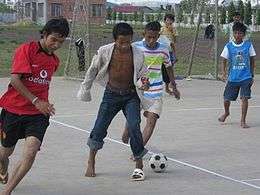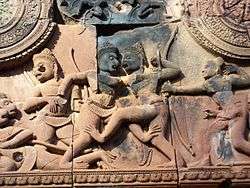Sport in Cambodia
| Part of a series on the |
| Culture of Cambodia |
|---|
 |
| History |
| People |
| Languages |
|
Traditions |
| Cuisine |
|
Festivals |
| Religion |
| Literature |
|
Music and performing arts |
| Sport |
|
Monuments |
|

Cambodia has increasingly become involved in sports over the last 30 years.
Football is popular as are martial arts in particular. Sepak takraw, which looks like volleyball, is also a very popular sport in Cambodia. The martial arts of Bokator, pradal serey (Khmer kickboxing) and Khmer traditional wrestling are all practiced in the country.
The ancient sport of Bokator
'Bokator/boxkator, or more formally, Labok Katao (which means wielding a wooden stick to fight lions), is an ancient Khmer martial art that is based on animal forms. It has ground fighting, close combat techniques and weaponry.
Unlike kickboxing, which is a sport fighting art, boxkator was a soldier's art, designed to be used on the battlefield. It can be considered a complete martial art, using strikes, throws, drags, trapping, locking, and some elements of ground fighting. Every single part of the body can be used as a weapon.
When fighting, bokator practitioners still wear the uniforms of ancient Khmer armies. A kroma (scarf) is folded around their waist and blue and red silk cords called sangvar day, are tied around the combatants head and biceps. In the past, it is said that the cords were enchanted to increase strength, although now they are just ceremonial.
The kroma shows the fighter's level of expertise. A series of grades, each taking at least five months to complete training seven days a week and two hours a day, are represented by different colors.
The first grade is white, followed by green, blue, red, brown, and then black which has 10 degrees.
After completing their initial training, fighters wear a black kroma (scarf) for at least another ten years. To attain the gold kroma, you must be a true master and must have done something great for boxkator. And to become a true master, it will definitely take some time as just in the unarmed portion of the art; there are between 8,000 and 10,000 different techniques; only 1,000 of which you have to learn to attain the black kroma.
The art contains 341 different styles, some of which are the duck, crab, horse, bird, dragon, eagle, crane, wind, fire, water, earth (or stone), king monkey, lion, elephant, apsara (traditional Hindu sacred nymph), and crocodile. Ancient Khmer armies. A kroma (scarf) is folded around their waist and blue and red silk cords called sangvar day, are tied around the combatants head and biceps. In the past, it is said that the cords were enchanted to increase strength, although now they are just ceremonial.
Because of its visually similar style, bokator (boxkator) is commonly wrongly described as a variant of modern kickboxing. Bokator has many forms based on styles as well as straight practical fighting techniques. While pradal serey is a more simplified freestyle fighting system which uses a few of the basic (white kroma) punching, elbow, kicking, and kneeing techniques.
Pradal Serey
Pradal serey, or Traditional Khmer kickboxing, is a popular sport in Cambodia. A match consists of five sets of three-minute rounds and takes place in a 6.1 meter square boxing ring. A one- or two-minute break occurs between each round. At the beginning of each match, boxers practice the praying rituals known as the Kun Kru. Traditional Cambodian music is played during the match. The music is played using the instruments of the skor yaul (a type of drum), the sraliai (a flute like instrument), and the stringed chhing. Boxers wear leather gloves and shorts.
Rules:
- A boxer is not allowed to strike his opponent while he is on the ground.
- A boxer is not allowed to bite.
- When an opponent can not fight anymore, the referee stops the fight.
- Blows to the back of the opponent are not allowed.
- A boxer may not hold on to the ropes.
- Blows to the genitals are prohibited.
Victory can be obtained by knockout. A knockout occurs when a boxer is knocked down to the ground and can not continue fighting after a 10-second count by the referee. Victory is also obtained from the end of the match, when judges decide by a point system which fighter was more effective. If fighters end up with the same score, a draw is called.
History

Styles of boxing have been practiced in Southeast Asia, since ancient times and were developed through the influence of martial arts from India.
Khmer people believe that pradal serey predates other Southeast Asian forms of kickboxing. The basis of this argument is the bas-relief of two man believed to practice pradal serey in Angkor ruin, but no actual evidence can confirm that.
Ultimately, pradal serey became a sport, during the days of the Colonial Cambodia. When the French came, they added western boxing gloves, timed rounds, and a boxing ring to civilize the art. Originally matches were fought in dirt pits with limited rules while hands were wrapped in rope.
The Near Extinction of Pradal Serey
On April 17, 1975, during the chaos of the Vietnam War, the Khmer Rouge overthrew Lon Nol's pro-Western government, which was crumbling after America left the Vietnam War. The Khmer Rouge's plan was to eliminate modern society and create an agrarian utopia.[1] The Khmer Rouge executed most educated people, people who had ties to the old government, and anyone who was believed to be a threat (doctors, teachers, soldiers, actors, singers, etc.), and restricted the remaining Cambodian population to what were effectively labor camps. Pradal serey was banned under the Khmer Rouge regime, and many boxers were executed, nearly causing the art to be wiped out. In January 1979, the Vietnamese, along with a token force of Khmers led by ex-Khmer Rouge officers, overthrew the Khmer Rouge. Thereafter pradal serey was gradually revived.
Pradal Serey Today
Pradal serey is making a strong comeback since its banishment back in the 1970s. Numerous gyms have opened and large masses of students, local and foreign, have come to train in Cambodia. There are weekly matches held, in which many are televised, and many of Cambodia's best have traveled internationally to compete. There are currently about 70 boxing clubs. Cambodia is attempting to market their style of boxing to the same caliber of Muay Thai.
Attempt of Cambodian to unite Southeast Asian Boxing Style
Cambodians had an attempt to unite Southeast Asia's boxing styles. At an ASEAN meeting in 1995 regarding the upcoming King's Cup Muay Thai competition, Cambodia wanted to rename Muay Thai as "Suwannaphum" boxing or "SEA Boxing", which represented Thailand, Cambodia, Laos, and Myanmar. Suwannaphum means "golden land" in both the Khmer and Thai, which came from the language of Pali, and refers to mainland Southeast Asia. "SEA" is a popular acronym referring to Southeast Asia.
Thailand would not compromise, stating that each Southeast Asian country has its own boxing style, and Thailand is the one who pushed their style into international sport. At the 2005 Southeast Asian Games, Cambodia did not enter the Muay Thai event in protest.
Notable Khmer Boxers
- Eh Phutong - Khmer Kickboxing Champion
- Oth Phouthoung - TV5 kickboxing champion
- Meas Chanta - International Khmer Kickboxer
- Pich Arun - International Khmer Kickboxer
- Pich Sophun - International Khmer Kickboxer
- Chey Kosal - International Khmer Kickboxer
- Chan Rothana - International Khmer Kickboxer - Yuthakun Khmer Master
- Bun Sothea - Cambodian S1 champion
- Try Kuntor - Cambodian Kickboxer
- Bing Leung - Cambodian Kickboxer
Khmer Traditional Wrestling
A Khmer traditional wrestling match consists of three rounds. A round may be won by forcing an opponent to his back. A wrestler wins the match by winning two of the three rounds. After each round, the loser is asked if he wishes to continue with the match.
Wrestlers participate in pre-match ritual dancing before the match. The match is accompanied by the music of two drums (called Skor Ngey and Chhmol, "female drum" and "male drum").
Traditional matches are held during the Khmer New Year and other Cambodian holidays.
Football
Football is the most popular sport in Cambodia. The Cambodian Football Federation is the governing body of football in Cambodia, controlling the Cambodian national football team. It was founded in 1933, and has been a member of FIFA since 1953, and the Asian Football Confederation (AFC) since 1957.
Phnom Pehn National Olympic Stadium is the national stadium, with a capacity of 48,529 in Phnom Penh.[2]
Basketball
The Cambodian Basketball League or CBL is the official Basketball League of Cambodia. It was founded in 2013. The top basketball players and teams from Cambodia compete for the CBL title every year at the Beeline Arena.
Rugby union
Sepak takraw
Sepak takraw is a "kick-volleyball" sport, that is popular in Southeast Asia. It may also be known as si or chinlon in Cambodia. This sport is featured in the Southeast Asian Games.
Traditional boat racing
Traditional boat racing is a popular sport in Cambodia. Competition usually take place during the water festival. Boats are usually long and contain large numbers of rowers.
See also
- Cambodia at the Olympics
- Beeline Arena owned by Banzai
There is a new indoor stadium in Phnom Penh, the Beeline Arena. Located at Sangkat Chroy Changvar, Khan Russei Keo. The arena was built to international standards. It is the first multi-purpose sports arena in Cambodia with international standard, including: - Multi-sports surface for futsal, basketball, volleyball and more - 2,000 person capacity - VIP lounge and restaurant - Sports, music, cultural and big screen events. Rental available.
- The first marina in Cambodia for all boaters, sailing and motor yachts.
In October 2013 in the harbor of the port of Sihanoukville opened the first in the history of Cambodia marina Oceania . [3] Marina is located on the harbor breakwater island of Koh Preab (Koh Prib).
References
- ↑ Sites, Kevin. July 18, 2006. Year Zero, Yahoo.com (retrieved November 5, 2006)
- ↑ VIP Sport Club, Phnom Penh's First Sport CLub
- ↑ marina Oceania